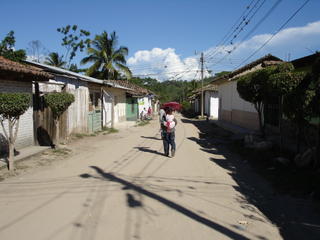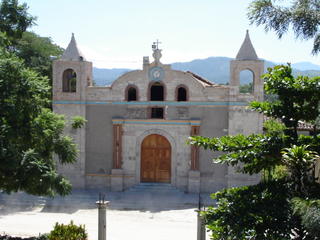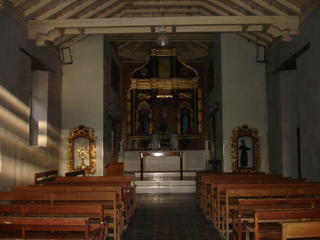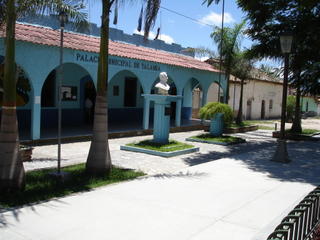By the way, just so you all know, it's not that I'm stingy about posting pictures. It's just that it takes forever, because the internet is so slow. For example, to post all the pictures for Terrero and Los Izotes has taken me a full 7 days of uploading pictures.
Anyways, here are the pictures from Los Izotes. James and I go there on Fridays. I think Los Izotes is the aldea closer to my heart. The people are just so welcoming (we can't visit a house without being offered food).
It's also farther from Talanga, which means that it is poorer. It takes us about 50 minutes driving to get there. They do not have electricity or running water. There is a bus that runs from Los Izotes to Talanga Fridays through Mondays, so that they can get into town fairly easily.
And they have AMAZING coffee. I don't even like coffee normally, but they grow, roast (in the sun), and grind their own coffee, and it tastes INCREDIBLE!! I doubt even the richest people in America have such good coffee. Not that I'm really an expert.
Ok, here are the pictures:

A view of a small part of Los Izotes. It is so gorgeous in this aldea. Sometimes I wonder if that's what really made me fall in love with it. You can't see the beautiful horizon in this picture, but take my word - it's gorgeous.
Also, that building whose roof you can just make out all the way on the left is the Catholic church, where James and I spend a lot of our time.

I'm really proud of this picture too. It's a shot of some sugarcane, which a lot of people in Los Izotes grow and sell to make some extra money. There's even a "galera" in Los Izotes - a place where the sugarcane is ground up, the juice heated until it turns the consistency of molasses, and then dried into cubes of sugar.
This sugarcane is probably 12 feet tall. The part you see sticking up is just the flower. Beneath it is a stalk like bamboo, which contains all the sweetness. The kids in the aldeas love to peel those stalks and munch on the tissue underneath. I like that too. It's not super super sweet, but its a bit sweet and cool and refreshing. And I feel quite Honduran munching away on it :).
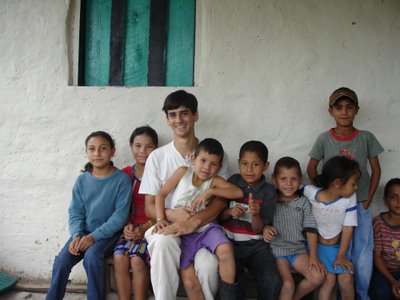 Me with several of the kids in Los Izotes. They're a cute bunch.
Me with several of the kids in Los Izotes. They're a cute bunch.
 Again, several of the Los Izotan kids.
Again, several of the Los Izotan kids.
 James rides a horse for, I believe, the 3rd or 4th time in his life. They let him ride it in a circle around the house several times this day. James really likes that horse!
James rides a horse for, I believe, the 3rd or 4th time in his life. They let him ride it in a circle around the house several times this day. James really likes that horse!
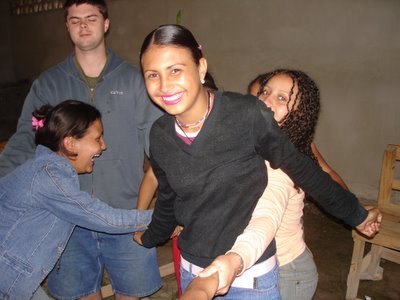 James and I run a youth group in the afternoons. Here, the kids are playing an icebreaker called "The Human Knot" (under James' watchful supervision). They all grab hands in a tangle, and try to untangle themselves without letting go of the hands. At first, they were super shy, and it was like pulling teeth to get them to play. But now, after several months, they go right to it.
James and I run a youth group in the afternoons. Here, the kids are playing an icebreaker called "The Human Knot" (under James' watchful supervision). They all grab hands in a tangle, and try to untangle themselves without letting go of the hands. At first, they were super shy, and it was like pulling teeth to get them to play. But now, after several months, they go right to it.
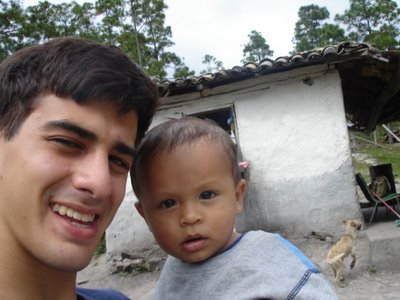 This is me with my little friend, Cesar. For some reason, he has always been very attached to me (they say he mistakes me for his father). Whatever the reason, he likes playing with me a lot. A few weeks ago, we had a good scare, because poor Cesar got a really bad case of diarrhea, which kills a lot of young children here. They took him to a doctor, though, and fortunately, he pulled through just fine.
This is me with my little friend, Cesar. For some reason, he has always been very attached to me (they say he mistakes me for his father). Whatever the reason, he likes playing with me a lot. A few weeks ago, we had a good scare, because poor Cesar got a really bad case of diarrhea, which kills a lot of young children here. They took him to a doctor, though, and fortunately, he pulled through just fine.

Several of the kids from Los Izotes, in front of the church. The people of Los Izotes are really proud of their church. They've worked hard to build it. It's still not done - you can see that the walls are unfinished, as is the floor inside. The big hitch is that they can't afford the materials. The cinder blocks and roof of the church were donated. From time to time, they have fundraisers to raise the money to continue work.
That's all the pictures for now. Until next time!
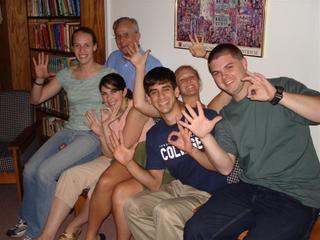




 Me with several of the kids in Los Izotes. They're a cute bunch.
Me with several of the kids in Los Izotes. They're a cute bunch. Again, several of the Los Izotan kids.
Again, several of the Los Izotan kids.




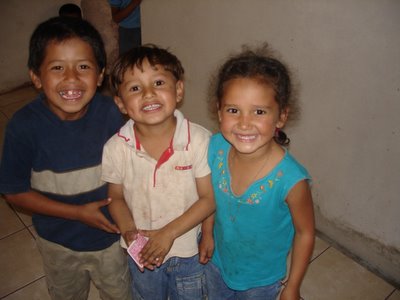


 I am quite, quite proud of this picture :). I really can't claim credit; it was just dumb luck. Her name is Danisela - she's three years old and just ADORABLE. She's also a bit of a terror to all the animals that live around. She's been known to toss kittens through the air and leave puppies stranded on a stool. But she is cute.
I am quite, quite proud of this picture :). I really can't claim credit; it was just dumb luck. Her name is Danisela - she's three years old and just ADORABLE. She's also a bit of a terror to all the animals that live around. She's been known to toss kittens through the air and leave puppies stranded on a stool. But she is cute. 









